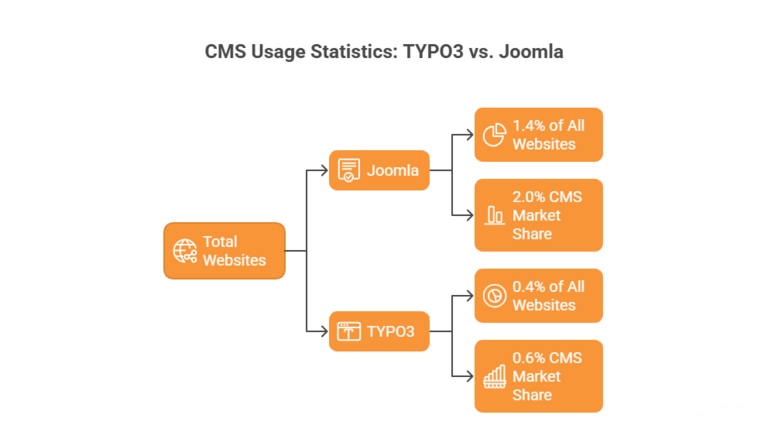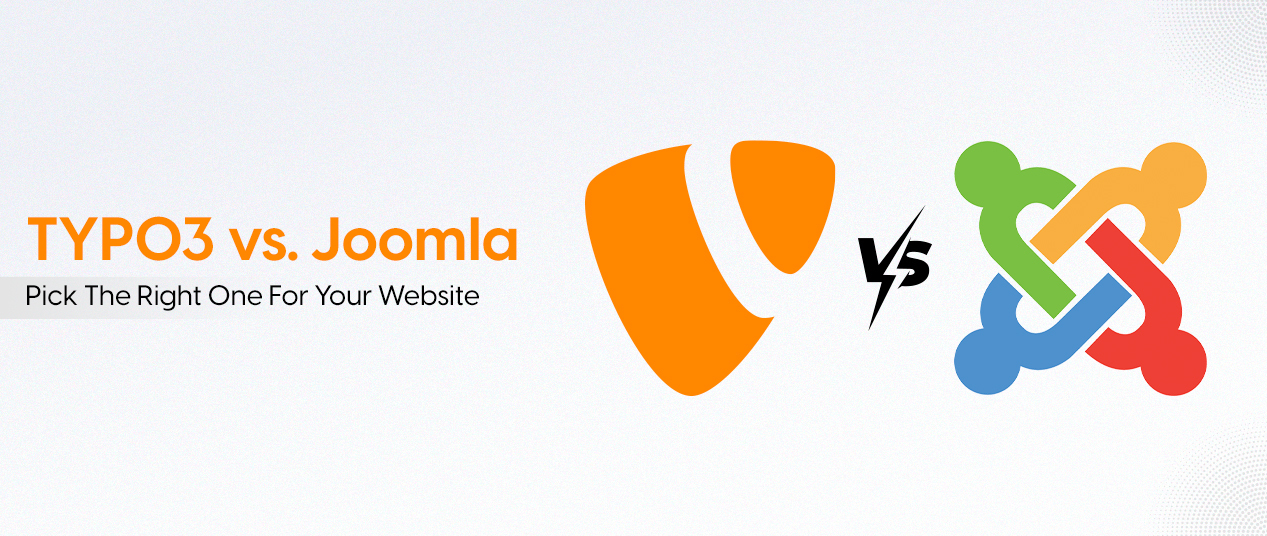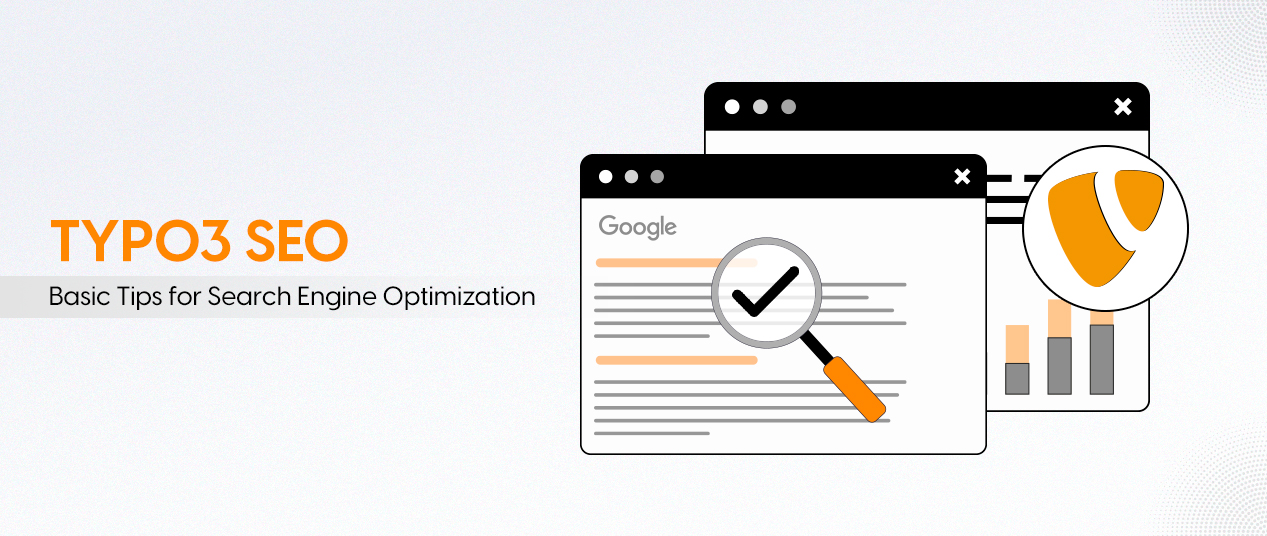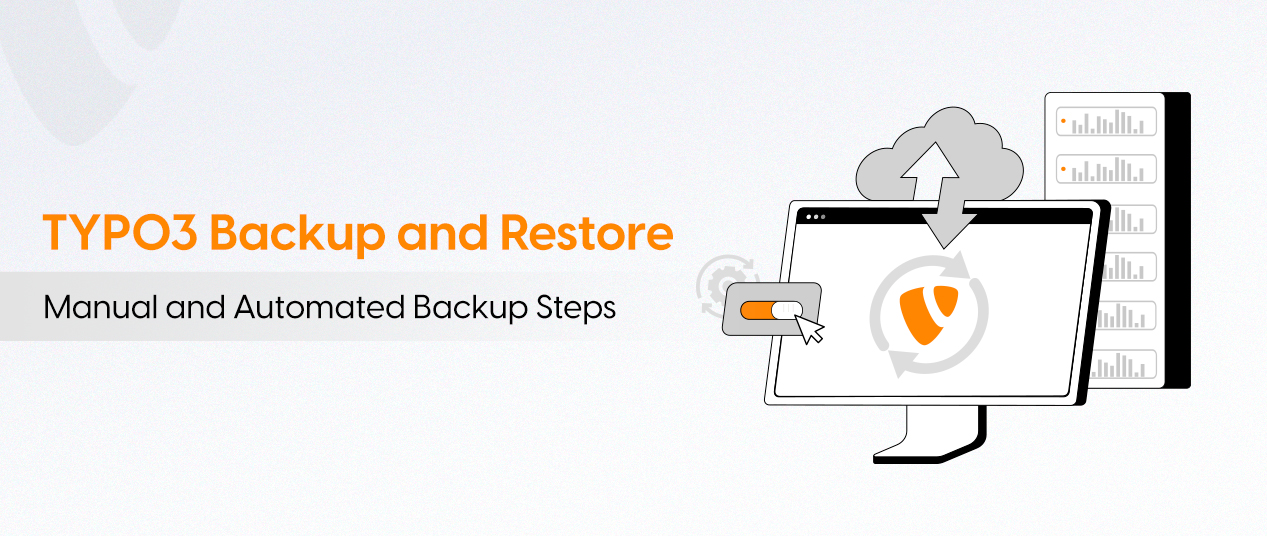When creating a new website, your CMS influences how easily you can build, update, and ultimately expand your online presence.
During the selection process, you will often come across two options: TYPO3 and Joomla. Both options are respected and both are Open Source, but they pursue very different approaches to get you to your goal.
This guide is intended to help you choose the system that is suitable for your journey.
Let's get started!
What is TYPO3?
TYPO3 is a robust CMS (Content Management System) for businesses known for reliable and controlled management of complex websites. TYPO3 is ideal for institutions needing more than a simple web presence.
TYPO3 offers integrated support for multilingual content, management of multiple websites, user permissions, and structured workflows. All these CTMS features are designed for scalability, making it particularly suitable for growing businesses.
TYPO3 is developed with a focus on security. In addition to regular LTS (Long Term Support) releases, TYPO3 has built-in security tools and a strict update policy.
TYPO3 is a CMS suitable for organizations, businesses, universities, and authorities valuing stability, precision, and powerful features representing quality.
What is Joomla?
Joomla is an easy-to-use, open-source content management system targeting individuals, small companies and community websites.
Joomla provides a nice mix between user-friendliness and flexibility, which is why some choose to use it for building and managing their websites when they want to get online without requiring too much technical skill.
That being said, Joomla does have limitations. While its typically have to be handled via third-party tools or workarounds.
Security of your Joomla site is also very reliant on the add-ons that you install. So you need to invest time into making sure you're making wise choices to secure your site.
Lastly, even though many find that it is easier to learn than certain platforms, it can still be a challenge over time to maintain it properly, mainly because it requires consistent updates and to ensure security.
TYPO3 vs. Joomla - CMS Usage Statistics.

- Joomla:
- Powers 1.4% of all websites, which equates to roughly a 2.0% CMS market share.
- When focusing on websites using a known CMS, Joomla's share rises to 2.0%.
- TYPO3:
- Runs on 0.4% of all websites, translating to about a 0.6% CMS market share.
- Among websites using a CMS, TYPO3 holds 0.6% of usage.
Source: w3techs.com
TYPO3 vs. Joomla – Side-by-Side Comparison
To help you clearly understand the strengths of each CMS, here’s a direct comparison across the most important areas. This can help you see which system fits your needs best.
Category | TYPO3 | Joomla |
Target Audience | Built for medium to large enterprises, public institutions, and complex digital platforms | Best for small to medium businesses, blogs, portfolios, and community sites |
Ease of Use | Built for professionals; requires technical knowledge | Easier to learn; more suitable for non-technical users |
Setup & Installation | More structured setup, takes time but scales well | Quick and simple installation process |
User Interface (Backend) | Detailed and powerful backend, ideal for advanced use cases | Clean, simple backend with user-friendly navigation |
Flexibility | Extremely flexible; tailored for custom solutions | Flexible, but more limited for large or complex projects |
Multilingual Support | Full native multilingual support; highly reliable | Good multilingual support, but more setup needed |
Multi-site Support | Native support for managing multiple websites in one backend | No built-in multi-site support; requires third-party extensions |
Extensions/Plugins | Rich library through TYPO3 Extension Repository (TER); enterprise-grade | Large extension directory; wider variety, including community-built |
Themes/Templates | More developer-focused; fewer pre-built themes | Wide variety of free and premium templates available |
Access Control (ACL) | Advanced user permissions and roles | Basic to moderate user role management |
SEO Tools | Strong built-in SEO tools; easy to manage technical SEO | Good SEO with plugins; not as detailed as TYPO3 |
Security | High-end security, trusted for enterprise and government use | Secure at core; extra caution needed with third-party plugins |
Community & Support | Professional ecosystem, excellent documentation, certified partners | Large open-source community; active forums and learning resources |
Performance | Optimized for large, high-traffic websites | Good for moderate traffic; may need tuning for bigger needs |
Updates & Maintenance | Stable with Long-Term Support (LTS) versions; professional-grade updates | Regular updates; easier to apply but often manual |
Cost | Free core; higher setup and maintenance cost due to complexity | Free core; lower setup cost; faster time to market |
Learning Curve | Steep, suited for developers and trained users | Gentle, suitable for beginners and small business owners |
Development Focus | Built for long-term, scalable, and secure platforms | Great for quick builds and dynamic content-driven websites |
Best Use Cases | Government websites, enterprise portals, universities, multilingual platforms | Blogs, local business sites, nonprofits, communities, and portfolios |
TYPO3 vs Joomla – Detailed Feature Comparison
Let’s focus on a few more of the biggest features that TYPO3 and Joomla differ. You can read some detail below to help clarify the above table, and we will use everyday language to help make decisions.
User-Friendliness
TYPO3 is developed for professionals. TYPO3 backend produces great power, but is not easy to learn. If you or your team has any web development experience, you will appreciate and understand everything TYPO3 is able to do once you have the Header and Footer properly configured.
Joomla is much more user-friendly for beginners. It’s admin panel is simple, and you can do most typical tasks, such as installing templates or publishing content, very quickly and without coding knowledge. It is perfect for the person that wants to get results but does not want to learn technical steps.
Features and Flexibility
In terms of features and flexibility, TYPO3 will win without question. Managing complex website needs, like having multiple user groups with different content, managing complex workflows or multiple language websites, are part of TYPO3’s feature set. It is purposefully built to help clients build something that they can expand and keep organized later on down the road.
Joomla is flexible in some terms but is best used for small projects. Certainly there are plug-ins you can add features to your website relatively quickly, however managing a large or multi-language site can become difficult. Regardless, it has plenty for many start-up small businesses or content purposes.
Community and Support
TYPO3 has a small, but very professional community. The documentation is thorough and there are certified agencies and developers who build TYPO3. If you're on a larger, "serious" project, you can count on solid support.
Joomla has a large, passionate global community. There are tons of tutorials with a bunch of active forums and user groups to get help from. Having all of these options makes it easier when you are troubleshooting problems or learning new features, especially if you are a non-technical user.
Security and Updates
TYPO3 has great security. They have exceptional coding standards and they always offer long term support (LTS) so when they do provide an update, your site is safe because it won't break your site. This is a huge reason why enterprise and government site large-scale sites trust it.
Joomla has good core security and is very similar, but because a lot of people choose to rely on third-party plug-ins, the overall safety of the site may vary. However, it is wise to be very selective on any extensions that are installed so that things can be maintained and updated to help overall performance.
Performance and Scalability
TYPO3 was built to scale. Whether you are adding more pages, or users, or translating pages, or even building out full websites, TYPO3's architecture allows for it to scale, without compromising. TYPO3 is meant to be around a while rather than a fad content management solution.
Joomla performs well for smaller to medium websites. It’s fast and responsive out of the box, but for very large websites or complex features, you may need extra tools or server optimization.
Some Advantages and Disadvantages
Both TYPO3 and Joomla, like any CMS, have their pros and cons to consider. Understanding these pros and cons will help you determine whether you think you can make the best decision based on project size, purpose (website), and available resources (time, budget, and available technical help).
Advantages and Disadvantages of TYPO3
Pros:
- A CMS designed for large complex sites with structured content.
- Built-in multilingual and multi-site capabilities.
- Strong user-role and permissions system.
- Explicitly long-term stable security.
- Good for enterprise-level needs with professionalism.
Cons:
- Steeper learning curve, especially for non-techies.
- Set-up and/or customization may require a developer.
- Has a smaller community than other CMS.
Advantages and Disadvantages of Joomla
Pros:
- Easy to install, manage, and maintain for non-techies.
- Fairly wide variety of templates/extentions available.
- Nice clean admin GUI (Graphic User Interface) for administrator.
- Large number of community users mean that there is a lot of free/low-cost learning.
- Flexible enough to work for many different types of sites.
Cons:
- Many of the advanced functions, and some basic features, require third-party extensions.
- Much trickier to manage large or multi-site projects.
- Security is dependent on the quality of plugins you add and the ongoing maintenance of them.
When to Choose TYPO3
You should consider using TYPO3 if your website needs more than just a publisher. TYPO3 is built for projects that require structure, reliability, and space for future growth.
If you are using multiple languages, have different teams, or are building a large digital platform, TYPO3 provides the features and functionality to manage all of this from a single source.
It may also be a good option if security is high on your priority list. TYPO3 follows strict standards and has long-term support to ensure your site is secure for the long run.
TYPO3 is more than just a CMS, it is a professional digital platform. If you have the technical support to help or you can access developers with incredible experience, TYPO3 becomes a long-term partner in your digital endeavours.
When to Choose Joomla
Joomla is an excellent option if you want to get a website up and running quickly, without going into technical depth. It's also a good choice if you are a small business, blogger, na entrepreneur, managing a simple to medium-complexity website, whether it is a non-profit or personal website.
If you don't have a developer or development team dedicated to support your web presence, Joomla will help you. You can install templates or plugins and manage and develop your content without a steep learning curve, even if it's your first run of a website.
Choose Joomla if you want simplicity, flexibility, and speed over deep customization or enterprise-level website features.
Conclusion
TYPO3 has facilities, power, and security so that you can pull all the pieces together when your project is large, complicated, and built for future expansion.
TYPO3 is made for professional, institutional, and team use when you need stability for the long term, multi-language, and fine-grained control of a user and content maintenance.
If you need something that is less work to maintain, deployed faster, and easier to learn, Joomla is a remarkable approach. It allows you to build great websites with less time and effort, and is especially useful for small businesses, personal sites, and community platforms.
Whatever you do, make sure it works for you - not the other way around.
If you do need the ability to structure, protect, and allow for grow, TYPO3 is a solid choice that is ready for the future. TYPO3 is built for serious websites that require more than the basics.
Would like to learn more? Contact a TYPO3 agency to become aware of what TYPO3 has to offer!
Contact for Internet agency and TYPO3 projects
Sven Thelemann
Service Partner - Germany






Be the First to Comment